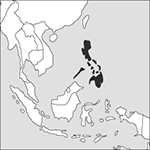
Source: MAPS IN MINUTES™ © RH Publications (1997)
Capital:
Manila
Area:
300,000 sq km (115,800 sq miles)
Population:
105,720,644 (2013 est)
Currency:
1 Philippine peso = 100 centavos
Religions:
Roman Catholic 80.9%; Muslim 5.0%; Protestant 2.8%
Ethnic Groups:
Tagalog 28.1%; Cebuano 13.1%; Ilocano 9.0%; Bisaya 7.6%; Hiligaynon Ilonggo 7.5%; Bicol 6.0%
Languages:
English, Pilipino (based on Tagalog) (both official); Tagalog; Cebuano; Ilocano; Hiligaynon; Bicol; Waray; Pampango; Pangasinan
International Organizations:
UN; Colombo Plan; ASEAN; Non-Aligned Movement; WTO
A country in south-eastern Asia comprising over 7000 islands between the Pacific Ocean and the South China Sea.
Physical
Luzon and Mindanao are the largest islands; in the central Philippines, the islands of Leyte and Samar are linked by a 2162 m (7095 feet) long bridge. Being at a junction of crustal plates they contain volcanoes and are subject to earthquakes; and as they are in the path of two monsoons there is rain for most of the year. The climate is tropical throughout the year. Many of the islands are mountainous and heavily forested with teak, ebony, and sandalwood. Bamboo and coconut palms grow in profusion.
Economy
Agriculture is the main economic activity, with sugar cane, coconuts, rice, maize, and fruit being important crops. Coconuts and fruit are exported, but other principal exports are all products of industry: semiconductors and other electronic products, transport equipment, clothing, and copper and oil products. Other mineral resources include coal, nickel ore, chromite, iron, silver, and gold. Remittances from expatriates are important.
History
The original Negrito inhabitants of the Philippines were largely displaced by waves of Malay peoples migrating from Yunnan province in south-west China after c.2000 bc. By 1000 ad the islands were within the south-east Asian trade network. By the 16th century Islam was advancing from Mindanao and Sulu into the central islands and Luzon. After Spaniards under Magellan visited the islands (1521), Spanish seamen discovered how to return eastbound across the Pacific to Mexico. In 1543 they named the islands after Prince Philip (later Philip II of Spain). In 1564 Miguel de Legazpi, with 380 men, set out from Mexico to establish a settlement, Christianize the Filipinos, open up commerce with East Asia, and secure a share of trade in the Moluccas. A settlement was made in 1565 at Cebu in the western Visayas, but the Spaniards moved their headquarters to Manila in 1571. Manila became the centre for a trade in Chinese silks with Mexico, in return for Mexican silver dollars. From there Spanish influence and control spread out through the Philippine island chain, particularly assisted by missionary activity. Christian outposts founded by Dominicans, Franciscans, and Augustinians grew into towns. Revolts against the harsh treatment of Filipinos by the Spanish were frequent, particularly in the 17th century. During the Seven Years War the British occupied Manila for two years.
In 1896, a nationalist uprising against the Spanish colonial authorities broke out in Manila, led by José Rizal. After the outbreak of the Spanish–American War in 1898, General Emilio Aguinaldo, acting with the support of the USA, declared the country’s independence. After Spain’s defeat, however, the nationalists found themselves opposed by the Americans, and after a brief war (1899–1901), the islands passed under US control. Internal self-government was granted in 1935, and, after the Japanese occupation during World War II, the Philippines became an independent republic in 1946 under the presidency of Manuel Roxas, with the USA continuing to maintain military bases. Successive administrations proved incapable of dealing with severe economic problems and regional unrest. In 1972, using the pretext of civil unrest, in particular the communist guerrilla insurgency conducted by the New People’s Army in Luzon, and violent campaigns of Muslim separatists, the Moro National Liberation Front, in the southern Philippines, President Marcos declared martial law, assuming dictatorial powers. While the Marcos regime achieved some success in dealing with both economic problems and guerrilla activities, the return to democratic government was never satisfactorily achieved and corruption was widespread, epitomized in the amassing of huge personal fortunes by the Marcos family. After the murder of the opposition leader, Benigno Aquino Jr, in 1983, resistance to the Marcos regime coalesced behind his widow Corazon Aquino and the United Nationalist Democratic Organization. US support for the Marcos government waned and in 1986, after a disputed election and a popularly backed military revolt, Marcos fled, and Corazon Aquino became President in his place, restoring the country to a fragile democracy. There were no fewer than six attempted military coups against President Aquino, who refused to stand for re-election. She was succeeded in 1992 by her ex-Defence Secretary Fidel Ramos, who completed arrangements for the withdrawal of US forces from Subic Bay and other military and naval installations. In 1996 a peace agreement with Muslim rebels was made. Presidential elections in 1998 were won by the left-wing Joseph Estrada. He resigned in 2001 amid allegations of bribery and corruption. He was succeeded as President by Gloria Macapagal-Arroyo, the Vice-President, who was re-elected in 2004. Political instability, allegations of corruption, and her authoritarian style of government led to two attempted coups (2003 and 2006). Benigno Aquino III, son of Benigno Jr and Corazon, was elected President in 2010. He remained popular thanks to his efforts to reduce poverty and combat corruption. He was succeeded in 2016 by anti-crime campaigner Rodrigo "Digong" Duterte.
- trade not aid
- trade-off
- trade policy
- Trade-Related Intellectual Property Rights
- Trade-Related Investment Measures
- trade sanctions
- trade secret
- Trades Union Congress
- trade talks
- trade union
- trade war
- trade-weighted index number
- trade wind inversion
- trade-wind inversion
- trade winds
- trading currency
- trading partner
- tradition
- Traditional Stratigraphic Scale
- traducianism
- Trafalgar, Battle of (21 October 1805)
- traffic
- traffic control
- traffic intensity
- traffic logging system